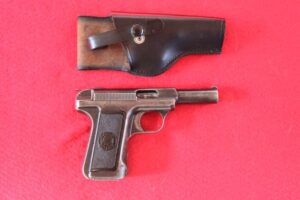From the time of its first introduction until sometime after WW2 the .32 ACP enjoyed a reputation as an adequate military and police round as most situations did not require stopping a fanatical attacker. Most of those shot either dropped or ran away rather than keep getting punctured. If a man did keep coming you shot for the head as he got close. Even if you missed the head if you had a .32 ACP in his boiler room it was going to let the steam out of him fast so his chances of prevailing in hand to hand combat against you were dropping by the second.
The FMJ ammunition had great penetration ability which saved many of its user’s lives in tight spots as it shot through a lot of the cover their enemy was attempting to use. Giving up this penetration for the negligible increase in stopping power of expanding .32 caliber bullets is a bad trade-off. You can’t make a .45 out of a .32 but you can quickly give up the .32 ACP’s big ace in the hole, penetration, by going to expanding bullets.

Savage .32 ACP with a holster of the period. One of the first high capacity double column pistol magazines it’s slogan was “10 shots quick.” The French military bought 40,000 of these and issued them in WW1.
Large numbers of .32 ACP pistols were employed by countries on both sides in both World Wars. A lot of these saw intense combat, especially in the trench fighting of the First World War. The fact that large numbers were still used in the Second World War shows how the Europeans felt about the FMJ .32 ACP round and how well it performed for them.
Up until WW2 concealed carry was popular in Europe and the .25ACP vest pocket pistols and the .32ACP pocket pistols dominated the market. Bigger calibers in larger pistols were available but this is what sold and got carried and used.
In those days, trappers often used a .32 ACP to finish off game in their traps as it killed far better than a .22LR without putting a noticeably bigger hole in the pelt. It was much more humane than a .22LR which sometimes did not give the desired result of a quick and merciful killing. There were instances of trappers even killing bear with .32 ACP pistols. Both bears in traps and a few instances of attacking bears were killed by the little round but no trapper ever set out to stop a bear charge with .32’s to the head and body of a bear. These things just happen sometimes to people who don’t also pack a rifle or a heavy caliber pistol on long lonely trap lines deep in the woods.
You might not think a .32 diameter 71-grain bullet at 960 FPS amounts to much but when you move up just a bit to the .380 ACP you increase recoil just enough that the casual shooter starts having trouble keeping his shots on target. That’s why for most of the history of these two cartridges the .32 was the most popular. A lot of European military officers and European policemen, not having a background with a lot of pistol shooting, fell into this category so the .32 ACP grew in popularity. In more recent decades the Czechoslovakian VZ/62 submachinegun was chambered for this cartridge. They sold quite a lot of these and I always thought that if the Ingram M11 SMG had been chambered for the .32ACP instead of the .380ACP that it would have been a bigger success as it’s extremely high rate of fire would have been lower with the lower recoiling round and the gun thus more controllable.
Far away in distant Japan the same situation was occurring. The Japanese wanted their own version of the .32 ACP so they adopted the .32-caliber 8MM Nambu bottle-necked cartridge with .32 ACP ballistics, an 83-grain bullet at 950 fps. It worked just fine. The Nambu pistol mimics the Luger’s grip angle and is also extremely accurate and pleasant to shoot. It’s so nice that I’d like to see it brought back in .32 ACP. Full size pistols are easier to hit with than pocket pistols and this would bring out all the accuracy potential of the .32 ACP.
The Japanese also used their 8MM Nambu cartridge in a very controllable SMG, their Type 100.
Civilian sales have always been the prime mover of the .32 ACP and its success with the world’s military and police clinched the deal for many buyers. All these customers were gravitating towards the biggest caliber that they could hit with reasonably well that still performed adequately for them.
For the casual shooter that would be the .32 ACP in a gun the size of a M1903 Colt or a Savage pocket pistol. Note that I am NOT including the super small modern micro mini .32’s as these do have more recoil than the casual shooter is going to tolerate well. These older .32’s are small and easy to carry and conceal. That is a very big deal to the casual pistol packer who is not deeply into shooting.
Are they ideal? No, a .45 ACP or a .45 Colt is ideal but they require more practice and more expensive ammo to master, something not everyone will commit to. The biggest gun that has no more recoil than a .22LR is what a lot of people need to be able to shoot accurately with what they carry and that is what the .32 ACP is all about. That is its niche and it fills it very well.





